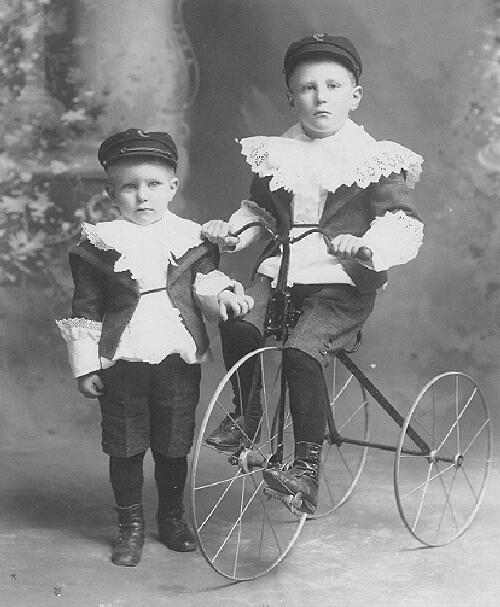
Lace Collars: Characteristics

Figure 1.--Here we see two unidentified American brothers with very elaborate lace collars and matching wrist trim. Note the caps, a style we do not commonly see with these fancy lace collars. The trike was presumably a studio prop. All we know about the portrait was tht it was taken in Portland Oregon. We would guess it was taken about 1890.
|
|
I have very little written information on the lace collars worn by boys. An examinatiion of the available photographic evidence, however, offers some basic information on the characteristics of the lace collars worn by boys. Some of the few written references we have stress only that boys were not to fond of these collars. Lace collars varied greatly in size. Some were quite small, about the size of an Eton collar. Many were quite large covering much of a boy's shoulder. There were all kinds of sizes in between these extremes. Collar materials varied. Some of the collars were purely made of lace and the boy's jacket was visible under the lace. Many other collars were made of linnen, chambrey, or other materials. Often these blouses had large collars that were trimmed in ruffles and lace. True lace collars lay flat. They came in many shapes. Some had a modern boy's collar or Eton collar shape. More commonly they were rounded like a large Peter Pan collar. Other collars have irregular geometric shapes. One popular version was a star like shape with points radiating out in all directions. Lace collars came in a wide variety of types and sizes. The one constant was that they were all white. Many of the available images unfortunaely are not clear enough to fully access the collars pictured. Boys' lace collars were almost always white. This was in part because they were usually worn with dark jackets and thus the white lace provided some contrast. Women might occasionally wear black lace, but I do not recall boys wearing anything, but white lace.
Sizes
Lace collars varied greatly in size. Some were quite small, about the size of an Eton collar. Many were quite large covering much of a boy's shoulder. There were all kinds of sizes in between these extremes. The size worn was significantly affected by the chronological period. Until the 1870s, the lace collars worn by boys could be quite small. From the late 1870s to the mid 1890s boys' lace collars could be very large. This was of course most pronounced during the Little Lord Fauntleroy craze after 1885.
Material
Collar materials varied. Some of the collars were purely made of lace and the boy's jacket was visible under the lace. Many other collars were made of linnen, chambrey, or other materials. Often these blouses had large collars that were trimmed in ruffles and lace. These coll ars often had a lacey look as lace work might be worked in on the fringe of the collar.
True lace collars lay flat. They came in many shapes. Some had a modern boy's collar or Eton collar shape. More commonly they were rounded like a large Peter Pan collar. Other collars have irregular geometric shapes. One popular version was a star like shape with points radiating out in all directions. The irregularly shapped lace collars appear to have been somewhat more popular for bots than the more rounded-shapped collars. The rounded shapped collars appear to have been more popular for girls.
Lace collars came in a wide variety of types and sizes. The one constant was that they were all white. Many of the available images unfortunaely are not clear enough to fully access the collars pictured. Some of the largest collars extending to and over the shoulders were part of the blouse. Some of the collars were all one material. Some colars were a combination of different materials. Often they had ruffles and lace trim along the outer edge. The trim on the outer edge of some collars, especilly the larger ones that extended to the shoulders were sometimes made to stand up perkily.
Size
True lace was expensive. As a result lace collars for boys could be modest in comparison to other collars. This changed markedly, however, in the late 19th Century with the popularity of Mrs. Burnett's Little Lord Fauntleroy. All of a sudden, mothers were vying with themselves to see who could put the largest lace and ruffled collars on their sons. Collars expanded well beyond the neck area. Fauntleroy lace collars commonly extended on to the shoulders and down the back. Some particularly large collars even fell over the shoulders and down the arms.
Boys' lace collars were almost always white. This was in part because they were usually worn with dark jackets and thus the white lace provided some contrast. Women might occasionally wear black lace, but I do not recall boys wearing anything, but white lace. A few lace collars had colored ribbons or other material worked into the lace collar--but this was not common.
HBC

Navigate the Boys' Historical Clothing Web Site:
[Return to the Main lace collar page]
[Introduction]
[Activities]
[Biographies]
[Chronology]
[Clothing styles]
[Countries]
[Bibliographies]
[Contributions]
[FAQs]
[Glossary]
[Satellite sites]
[Tools]
[Boys' Clothing Home]
Created: 6:40 PM 3/19/2005
Last updated: 6:40 PM 3/19/2005



